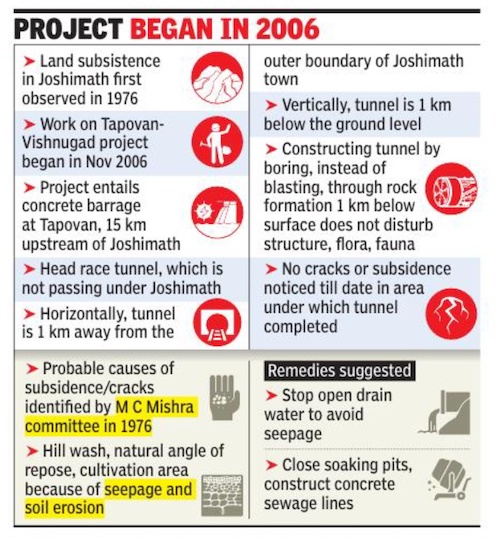Joshimath/ Jyotirmath
This article has been extracted from THE IMPERIAL GAZETTEER OF INDIA , 1908. OXFORD, AT THE CLARENDON PRESS. |
Note: National, provincial and district boundaries have changed considerably since 1908. Typically, old states, ‘divisions’ and districts have been broken into smaller units, and many tahsils upgraded to districts. Some units have since been renamed. Therefore, this article is being posted mainly for its historical value.
Contents |
Joshimath
Village in Garhwal District, United Provinces, situated in 30 degree 33' N. and 79 degree 35' E., at an elevation of 6,107 feet above sea- level and about 1,500 feet above the confluence of the Dhauli and Bishanganga, the combined stream being known as the Alaknanda. Population (1900), 468 in summer and a little larger in winter. It is chiefly remarkable as the winter head-quarters of the rawal or chief priest of the temple of Badrinath, who retires here after the snows have rendered the higher shrine inaccessible. The village contains several ancient temples, some of which have been much damaged by earthquakes. A police station is opened here during the pilgrim season.
Geology
The town is sinking slowly
Sep 17, 2022: The Times of India
Dehradun : Large chunks of Joshimath, the quaint town located at a height of over 6,000 feet in Uttarakhand and considered to be of strategic importance because of its proximity to the Chinese border, are slowly sinking, reports Gaurav Talwar.
Ateam formed to undertake geological and geotechnical investigation around the town in Chamoli found it is built on an unstable foundation — a thick cover of landslide material — which can give way in case of heavy rain, tremors, unregulated construction or more footfall than the town’s carrying capacity. It blamed the “sinking” on the numerous homes, resorts and hotels that have mushroomed along the Joshimath-Auli road. Poor drainage, sewage and erosion by rivers have compounded the situation.
Ntpc role denied
Sanjay Dutta, January 14, 2023: The Times of India

From: Sanjay Dutta, January 14, 2023: The Times of India
New Delhi : There is no ground evidence that drilling of tunnel for NTPC’s 520 MW Tapovan Vishnugad hydel project was inducing instability in the Joshimath area project, an expert committee set up by the government had said in August 2010 on continued land subsidence in the pilgrim town of Uttarakhand’s Chamoli district.
The committee under Chamoli DM, set up after people raised concerns over water level sinking in Selong area, had experts from IIT Roorkee, Wadia Institute of Himalayan Geology and National Environmental Engineering Institute as members.
The committee’s conclusion bears out even today, 12 years after the tunnel was completed in this stretch in August 2011. Till date, there is no sign of subsidence around the tunnel alignment at the overground surface. There is also no sign of any damage to surface flora or fauna at the site. This underlines the fact company engineers have been stressing time and again that drilling/boring through rock formations more than 1km below the surface does not disturb the structure or surface flora and fauna. The engineers also pointed out that the tunnel is more than 1 km away from town’s outer perimeter.
The project, which also envisages a concrete barrage 15 km upstream of Joshimath, has been drawing flak from the public for the crisisfacing the town due to land subsidence. Two other panels — one set up in 1976 and the other in August 2022 — also blamed the geography and water seepage from various sources as the main reason for the subsidence and not the project.
Broadly, the findings by both the committees weresimilar as they identified geography and habitation as the reasons for the subsidence. Hill wash, natural slope (angle of repose), cultivation, seepage and soil erosion were listed among the probable causes of subsidence. The recommendation was to stop open drain, closing of soaking pits and construction of concrete sewage to stop seepage. Sources said the findings in the reports have found an echo at recent review meetings at the Centre and its communications to provide perspective to the state.
The first committee to study the reasons of instability of Joshimath was set up under then Garhwal commissioner M C Mishra by the UP government after instance of subsidence came to light for the first time in 1976. Yet another panel under DM Chamoli was set up in August 2022 to look into continued subsistence. The Mishra committee described Joshimath as highly unstable because it lies on an ancient landslide and is “situated on weathered, landslide mass of big unsettled boulders in the loose matrix of fence micaceous sandy and clayey material”.